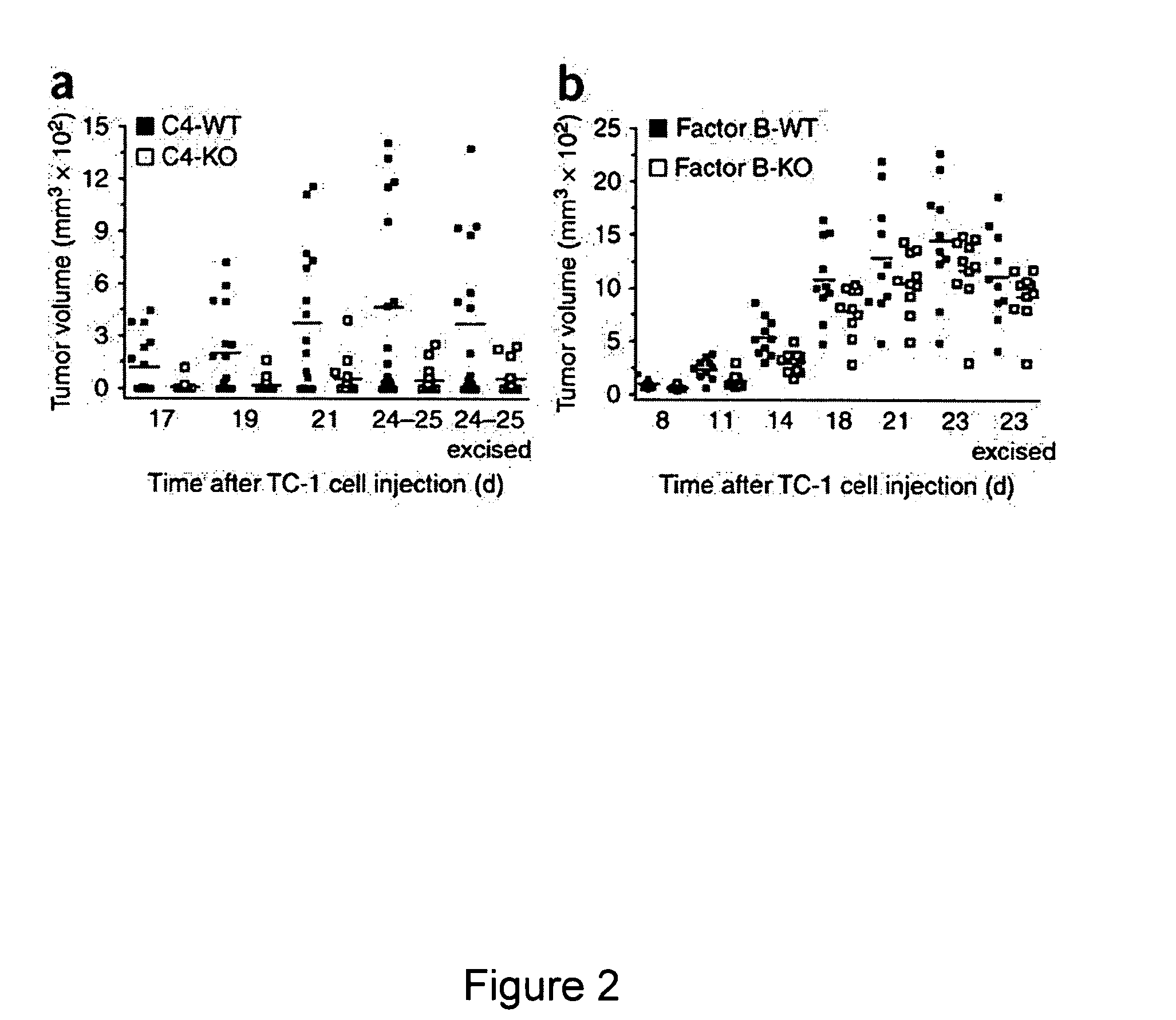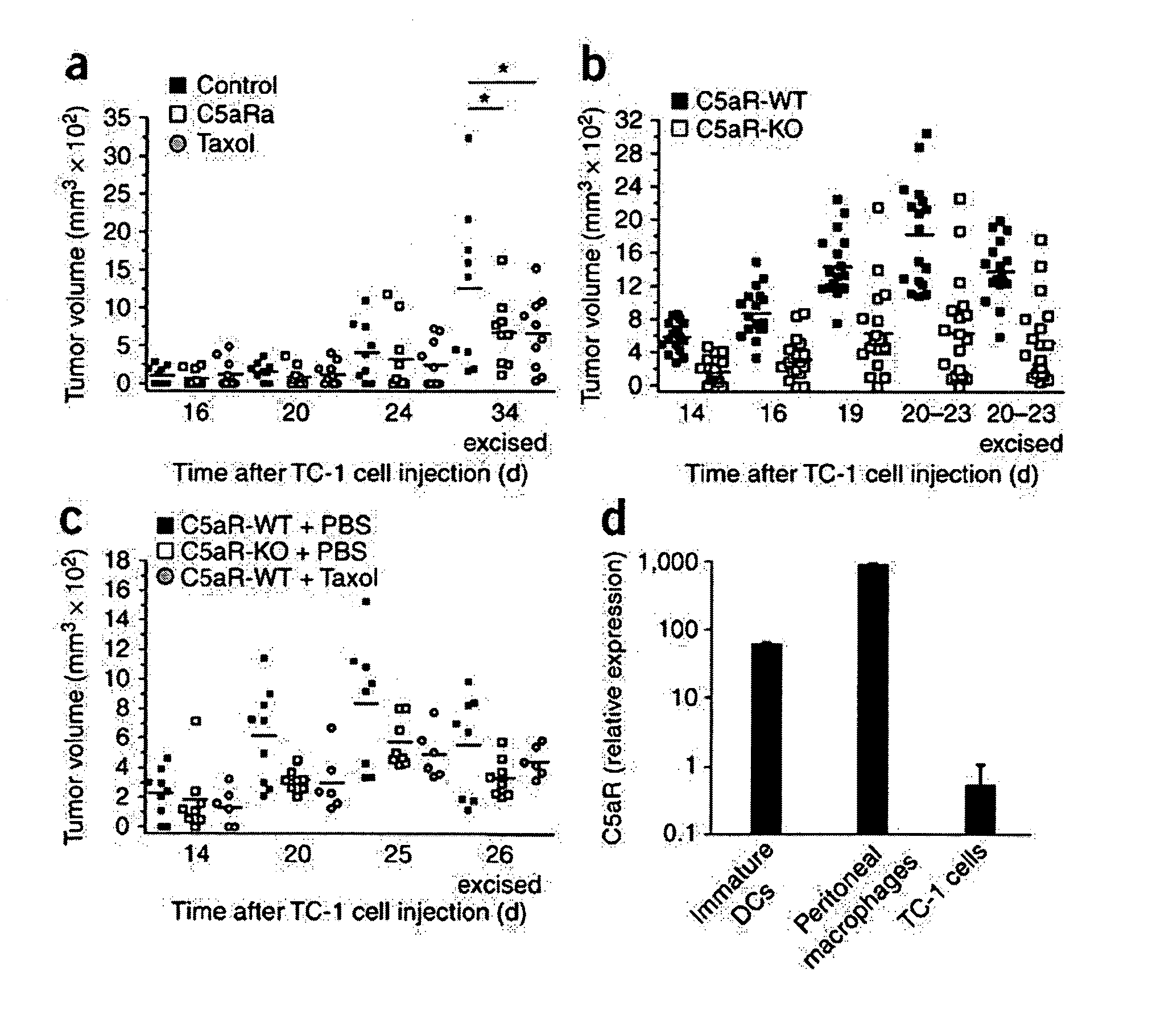Complement inhibitors as therapeutic agents for treatment of cancer
a technology of complement inhibitors and cancer, which is applied in the field of oncology and cancer therapy, can solve problems that have not yet been explored, and achieve the effects of reducing or preventing the signaling of the c5a receptor in the tumor, preventing, reducing or delaying the growth of the tumor
- Summary
- Abstract
- Description
- Claims
- Application Information
AI Technical Summary
Benefits of technology
Problems solved by technology
Method used
Image
Examples
example 1
[0087]This example describes materials and procedures, the results of which are set forth in the subsequent examples.
[0088]In vivo studies and reagents. All mouse experiments were performed according to the National Institutes of Health (NIH) guidelines. Mice deficient in complement component C3, C4, factor B and the C5a receptor (C5aR)-deficient mice utilized in our studies have been previously described (Circolo, et al., 1999, Immunopharmacology 42, 135-149; Wessels, et al., 1995, Proc. Natl. Acad. Sci. USA 92, 11490-11494; Matsumoto, et al. 1997, Proc. Natl. Acad. Sci. USA 94, 8720-8725; Hopken, 1996, Nature 383, 86-89). Mice deficient in C4 and C57BL / 6 mice were purchased from The Jackson Laboratory. Mice were backcrossed for at least nine generations onto a C57BL / 6 background, and their homozygous wild-type littermates were used as controls. Mice were housed in an animal facility of the University of Pennsylvania, within a barrier, on a 12-h light / dark cycle. Water and standard...
example 2
[0104]Studies were performed to determine whether complement effector proteins could promote tumor development. Many of the functions of complement are mediated by complement effectors such as C3a, C5a and MAC that are generated during the process of complement activation. It was hypothesized that these complement effectors are similarly generated during tumor development. In order to test this hypothesis, the TC-1 syngeneic model of cervical cancer in mice was used. In this model, flank tumors rapidly develop after subcutaneous (s.c.) injection of cancer cells. The activation of complement was monitored in these tumor-engrafted mice by immunofluorescent staining, which showed that C3 cleavage products were extensively deposited along the tumor vasculature in wild-type mice. As expected, staining was not observed in tumors from C3-deficient mice (data not shown), whereas in benign tissue surrounding tumors in wild-type mice only scattered C3 deposits were visible. C3 is the main pro...
example 3
[0105]Because the formation of C3 convertase is the key point in the complement cascade, the elimination of C3 prevents the generation of complement effectors (Markiewski et al., 2007, Am. J. Pathol. 171:715-727) and eliminates a wide range of activities that are mediated by these molecules. As described in the previous example, deposition of C3 cleavage products was detected in the microenvironment of TC-1 tumors. This example describes an assessment of the levels of tumor growth in C3-deficient mice after subcutaneous (s.c.) inoculation with TC-1 tumor cells. This animal model is viewed as a model of cervical (uterine cervix) carcinoma. Tumor volumes measured at various times after s.c. inoculation of tumor cells were significantly reduced in the C3-deficient mice as compared with wild-type littermate controls at all the time points examined (FIG. 1). The absence of the deposition of C3 cleavage products in tumor tissue from C3-deficient mice demonstrated that the injected TC-1 ce...
PUM
 Login to View More
Login to View More Abstract
Description
Claims
Application Information
 Login to View More
Login to View More - R&D
- Intellectual Property
- Life Sciences
- Materials
- Tech Scout
- Unparalleled Data Quality
- Higher Quality Content
- 60% Fewer Hallucinations
Browse by: Latest US Patents, China's latest patents, Technical Efficacy Thesaurus, Application Domain, Technology Topic, Popular Technical Reports.
© 2025 PatSnap. All rights reserved.Legal|Privacy policy|Modern Slavery Act Transparency Statement|Sitemap|About US| Contact US: help@patsnap.com



